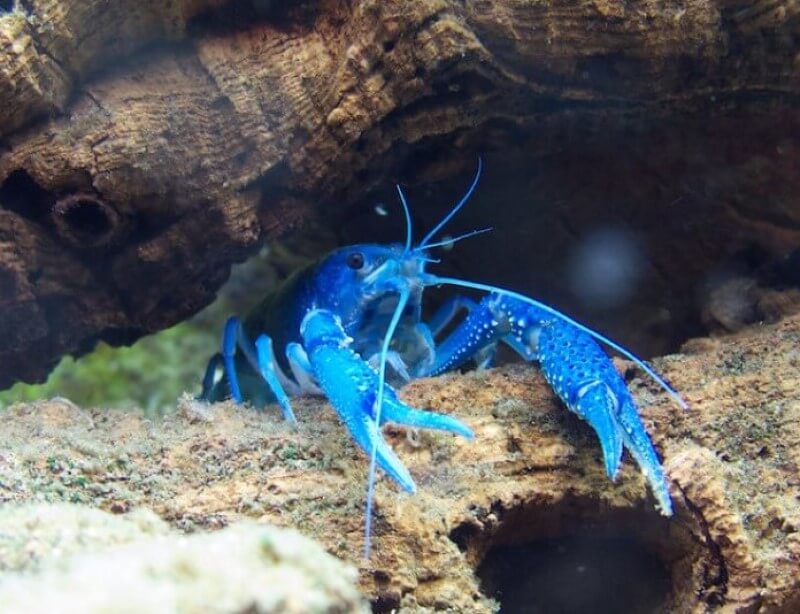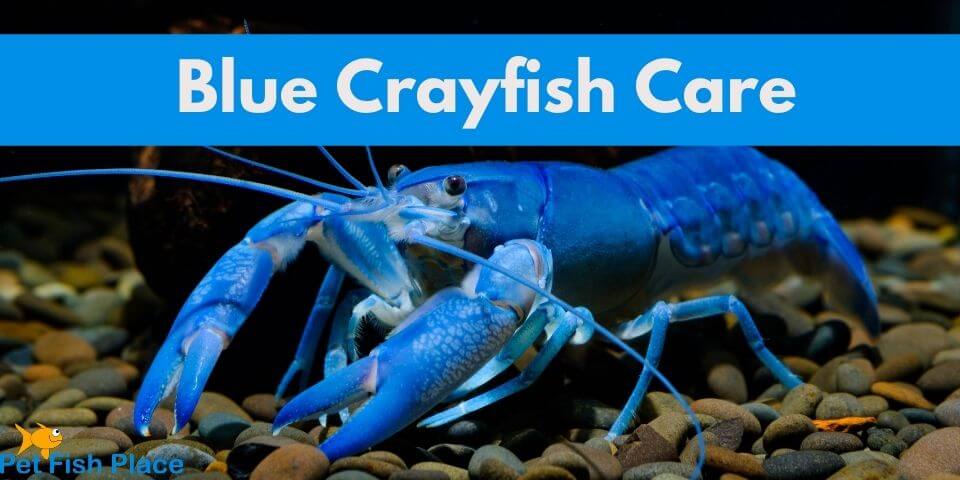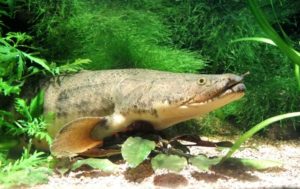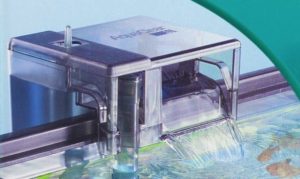Sharing is caring!
In this article, we’ll take a look at the intriguing and uniquely-colored electric blue crayfish. You’ll learn some basic facts about this wild little animal and how to care for these little guys.
Quick Facts on Blue Crayfish
- Care level: Beginner
- Origin: Florida
- Species: Procambarus alleni
- Temperament: Aggressive and territorial.
- Diet in Captivity: Sinking algae pellets, bloodworms, frozen vegetables.
- Lifespan: 3 to 5 years in captivity.
Origin
The electric blue crayfish is native to the Southern parts of the United States, specifically Florida. Here, Florida crayfish can be found in ponds, lakes, streams, and rivers throughout the Sunshine state.
Interestingly enough, the blue crayfish is a variation of the white crayfish, which is also a member of the Procambarus alleni family.
Why is the Blue Crayfish Blue?
Some people tend to think that the blue crayfish’s color is produced by artificial means. However, the blue crayfish’s brilliant bright blue color is caused by a genetic defect.
Today, they are bred for their “electric” blue color and sought after by aquarists all over. Yes, the color is intense, but it’s authentic.

Temperament
After keeping multiple crayfish for several years, I can tell you that blue crayfish can be quite aggressive and territorial.
When keeping blue crayfish in an aquarium, you can often find them chasing after your fish and other crayfish if you have them. We’ll look at the importance of tank size and tank mates for crayfish below in the article.
Tank Size: Blue Crayfish Need Some Room
When looking online at blue crayfish videos, you might sometimes see them in smaller aquariums. One popular video I’ve seen shows a blue crayfish in a five-gallon fish tank. But, please note, when keeping any full-size crayfish in captivity, it’s suggested that at least a 20-gallon fish tank be used.
Crayfish need room to move around. Also, if you plan on keeping other fish in your aquarium, you’ll need the extra space.
It’s very important that you consider the types of fish you are going to keep with your blue crawfish. Because blue crawfish, when paired with the wrong tank mates, will eat them. More on this later.
Setting Up a Blue Crayfish Aquarium
When you are setting up a tank for your crayfish, again, you want at least a 20-gallon fish tank. Yes, you may get away with a 10-gallon fish tank or even smaller, but many aquarists will recommend a 20-gallon fish tank minimum.
Placement can be a big deal when owning an aquarium. If you are looking to keep your tank healthy, try and place it somewhere out of the direct line of the sunlight. Sunlight can often promote an overgrowth of algae in fish tanks leading to not only an ugly tank but an unhealthy living environment for your crayfish and other fish.
As you prepare your tank for your crayfish, you will want to place fine gravel in the bottom of your tank. Also, you will want to add multiple hideouts for your crayfish. If you are looking to save a few bucks, PVC pipe can work great as a hideout for crayfish.
When it comes to keeping plants in a crayfish tank, many crayfish keepers will recommend against it. The reason is that crayfish will destroy plants in the tank. You can go with plastic plants or even use real plants if you want. But understand, your blue crayfish will probably have their way with them at some point.
As with any fish tank, after first setting it up, be sure to add conditioned water and cycle your tank. Properly cycling a tank is essential for establishing the beneficial bacteria that help neutralize toxins in an aquarium. Never add any fish or crayfish to a tank without first cycling the tank.
Water Parameters and Water Changes
For crayfish, the water temperature should be kept around 70 to 75 degrees. These temperatures will work great for your crayfish. The pH should be kept at around 7.

It’s worthwhile to invest in a water testing kit for your tank so you can check the pH of your tank regularly. Also, a water testing kit will allow you to check other important parameters, such as ammonia, nitrite, and nitrate levels in your aquarium.
Crayfish are pretty dirty little animals. For something so small, these guys put out a lot of waste. This is why you want to do regular water changes.
Depending on your tank’s size and what other fish you have in it, 20 to 25% water changes weekly or bi-weekly will work best. Again, the amount and frequency will depend on your tank size and other aquatic life.
TIP: Although crayfish are relatively hardy creatures, try to avoid massive water changes. The drastic water changes can sometimes lead to unsuccessful molts, which may kill your crayfish.
Why Blue Crayfish Need Plenty of Hideouts
Yes, these little blue creatures can indeed be very active in the fish tank. But at the same time, crayfish naturally love to burrow and hideout. Also, crayfish need a hideout during molting.
If you ever notice that your crayfish is less energetic, not eating, and spending a fair bit of time hidden, it’s probably okay. Most of the time, this type of behavior signals that your crayfish is about to molt, which is perfectly normal as crayfish grow.
When crayfish molt, they are at their weakest. This is a period when they are more vulnerable to other fish who may attack them.
Note, when a crayfish molts, they will, of course, shed their exoskeleton. Never remove it from the tank. Your crayfish will eat this, and it will help them regain their strength.
Feeding Your Crayfish
Blue crayfish are omnivores. I mean, these guys will pretty much eat anything they can catch.
In the wild, crayfish eat plant matter, dead fish, larvae, insects, and various other things. However, in captivity, crayfish can be fed sinking algae pellets, brine shrimp, bloodworms, and frozen vegetables. Ideally, it’s a good idea to change up the diet for your crayfish.
Tank Mates for the Florida Crawfish
If you decide to keep your crayfish with other freshwater fish, you must choose the right fish. Of course, the reason is that crawfish are incredibly aggressive and will eat any fish in your tank if given the opportunity.
When selecting fish to live with your crawfish, be sure to pick fish that are fast swimmers and swim near the middle to the top of your aquarium. If you choose bottom feeders or slow-moving fish, their chances of surviving with a crayfish aren’t too good.

Good tank mates for your crayfish include:
- Neon tetras
- Tiger barbs
- Mollies
- Rainbow sharks
- Rosy red minnows
- Rainbow darters
When stocking your tank, remember the general rule of one inch of fish per gallon of water. Also, recognize the importance of regular water changes, especially with a blue crayfish.
One inch of fish per gallon is a general rule. Each fish will have its own needs and you should do proper research into all your inhabitant’s requirements.
Blue Crayfish: The Wrap
Keeping the phenomenal Florida crayfish can be a fun hobby. But it’s essential to make the right choices when setting up a tank for a crayfish. Again, it’s recommended that crayfish be kept in a tank that is no less than 20-gallons. This will give your crayfish room to move about, allow you to place other fish in the tank, and help with keeping the water clean. Also, don’t forget to add those hideouts.
Crayfish are not picky eaters. They should be fed a mixture of algae pellets, frozen veggies, and bloodworms. Just remember, these guys love to eat and put out a lot of waste. So be sure to do regular water changes.
It’s important to note that if you ever decide you don’t want your crayfish, never release it into the wild. Instead, find another aquarist interested in your crayfish or return your crayfish to the pet store.
Sharing is caring!





